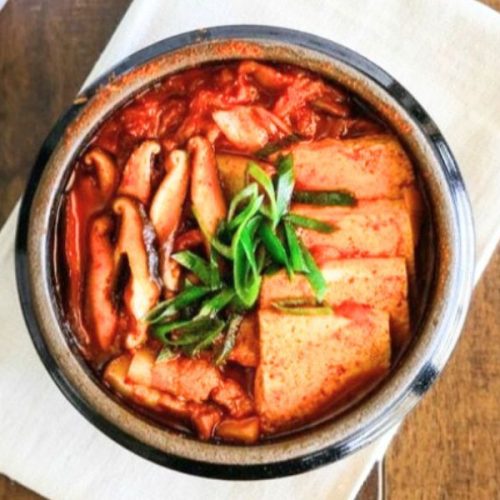
30-Minutes Kimchi Jjigae Recipe
A hearty, savory Korean stew featuring tender pork, fermented kimchi, tofu, and mushrooms in a rich, mildly spicy broth—ready in just 30 minutes.
Equipment
- 1 clay pot or medium pot (1–1.5 L capacity)
- 1 skillet (optional)
- 1 Chef’s Knife
- 1 Cutting Board
- 1 Mixing Bowl
- Measuring cups and spoons
Ingredients
Meat
- 180 g pork belly skinless, cut into bite-size pieces
- 1 Tbsp sweet rice wine mirin
- 3 sprinkles ground black pepper
Kimchi & Vegetables
- 3/4 cup aged kimchi 2–3 weeks old, bite-size pieces
- 30 g 1/4 small brown onion, thinly sliced
- 5 g 1/2 stalk green onion, thinly sliced
- 50 g 2 small shiitake mushrooms, thinly sliced
- 150 g firm tofu cut into 1 cm slices
- 1 cup water
Jjigae Base
- 1 Tbsp Korean chili flakes gochugaru
- 1 Tbsp soy sauce
- 1 tsp Korean chili paste gochujang
- 1/4 tsp minced garlic
- 3 sprinkles ground black pepper
Instructions
- Prepare the Pork Belly: Begin by cutting your skinless pork belly into bite-sized pieces, roughly 2–3 cm each, to ensure they cook evenly and remain tender. Place the pork in a medium mixing bowl, then add 1 tablespoon of sweet rice wine (mirin) and sprinkle with a pinch of black pepper. Using clean hands or a spoon, mix the pork thoroughly so every piece is lightly coated. Cover the bowl with plastic wrap and let it marinate at room temperature for 15 minutes.This step allows the alcohol in the mirin to tenderize the meat while enhancing its natural flavor.
- Prepare the Vegetables and Tofu: While the pork is marinating, prepare the kimchi, mushrooms, onions, green onions, and tofu. If your kimchi is not pre-cut, chop it into bite-sized pieces for easy eating. Thinly slice the brown onion and remove the stems from the shiitake mushrooms before slicing them.Cut the tofu into 1 cm thick rectangles or your preferred shape. Keep the green onions separate; they will be added at the very end for a fresh, bright flavor. Setting aside the ingredients now ensures a smooth, organized cooking process.
- Pre-Cook the Kimchi (Optional but Recommended): In a medium skillet, over medium heat, lightly sauté the kimchi until it becomes soft and slightly fragrant, about 5–7 minutes. This caramelizes the natural sugars in the kimchi, intensifying its flavor and adding depth to the stew. If your cooking pot is large enough, you can skip this step and cook the kimchi directly in the pot.
- Assemble the Stew: Take a clay pot or medium-sized pot with at least a 1–1.5 liter capacity. Place the marinated pork belly at the bottom of the pot in an even layer.Then carefully layer in the sautéed (or raw) kimchi, sliced onions, mushrooms, and tofu. Pour in 1 cup of water to create the base for the stew. In a small mixing bowl, combine 1 tablespoon Korean chili flakes, 1 tablespoon soy sauce, 1 teaspoon Korean chili paste, 1/4 teaspoon minced garlic, and a few sprinkles of black pepper. Stir this jjigae base until fully mixed, then pour it evenly over the other ingredients in the pot.
- Cook the Stew: Place the pot over medium-high heat and bring it to a gentle boil. Once boiling, reduce the heat to medium and allow the stew to simmer. Gently stir the broth occasionally, spooning the liquid over the tofu and pork to ensure all ingredients absorb the rich flavors evenly. Cook for approximately 10–15 minutes, or until the pork is thoroughly cooked and tender.The stew should be aromatic, with the flavors of kimchi, chili, and soy blending beautifully.
- Add Green Onions and Final Touches: Once the meat is cooked, stir in the thinly sliced green onions.This final step adds a burst of color, freshness, and subtle sharpness that complements the deep, savory flavors of the stew. Give the pot a gentle final mix to combine everything without breaking the tofu. Taste the broth and adjust seasoning if necessary—add a bit more soy sauce for saltiness or chili flakes for extra heat.
- Serve and Enjoy: Ladle the steaming kimchi jjigae into individual bowls and serve immediately alongside a bowl of warm steamed rice. For a traditional Korean experience, accompany the stew with banchan (small side dishes). The stew can be enjoyed hot, and any leftovers taste even better the next day as the flavors continue to meld.
Notes
- Marinate pork belly for at least 15 minutes to ensure tender, flavorful meat.
- Use aged kimchi (2–3 weeks old) for a richer, more tangy flavor.
- Pre-cooking kimchi in a skillet is optional but enhances depth and aroma.
- Adjust spice levels by increasing or reducing gochugaru and gochujang.
- Gently stir tofu to prevent it from breaking apart during cooking.
- Leftover stew tastes even better the next day as flavors intensify.
- Use a clay pot or heavy-bottomed pot to retain heat and evenly cook the stew.